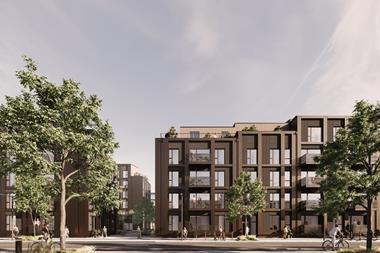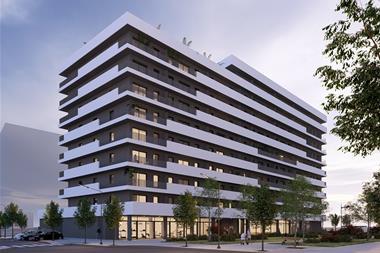Data quantifying the value case for sustainable real estate is growing, driven by institutional interest and regulation. Leanne Tobias reports
As US financial institutions continue to write off billions in sub-prime and other property debt, green buildings are beginning to look like increasingly attractive opportunities for institutions searching for high-quality US real estate investments. While sustainable buildings - like conventional projects - must prove their worth in a contracting economy, the new green asset class continues to gain adherents. As RREEF observed in a November 2007 report (1): "Green building is fundamentally altering real estate market dynamics....The upshot will be a redefinition of what constitutes class-A properties and even institutional real estate."
RREEF and others have identified a number of drivers leading to the adoption of sustainable building practices by the US commercial real estate industry, including shifting tenant expectations for high-end space, concerns about accelerating energy costs and the threat of climate change, the combined impact of regulatory mandates and public incentives, and the goodwill benefits accruing to developers and institutional owners who adopt green practices. While the energy savings associated with green building are well known - green buildings typically reduce fuel costs by 30% or more - the broader financial benefits of green buildings are just beginning to be quantified in large-scale, empirical studies.
Early case study data assembled by US development and investment professionals suggested that green buildings experienced accelerated lease-up, higher occupancy rates, occasional rental premiums and top-tier sale pricing. Most institutional investors were hesitant to commit significant capital to the green real estate sector in the absence of broad, quantitative studies demonstrating yield enhancement.
The breakthrough in assembling a substantial US data set began in 2006, when CoStar Group, one of the largest providers of US property performance data, began to track performance metrics for energy-efficient properties certified under the US government's Energy Star programme and for green buildings certified under the US Green Building Council's Leadership in Energy and Environmental Design (LEED) requirements. The CoStar information is the first large-scale database that permits comparison between conventional, energy-efficient and green properties in the US.
The CoStar findings, which are drawn from a database representing 44bn ft2 of conventional space and 351m ft2 of LEED- and Energy Star-certified property, have been refined and updated over the past 15 months. March 2008 data provides matched comparisons, controlled for location, real estate product type, class, age, and size, between conventional, Energy Star-, LEED-certified and conventional buildings. Results - which validate the earlier case study findings - demonstrate that LEED and Energy Star properties attain higher occupancies, rental rates and sales prices than their conventional peers.
Strong tenant demand for green buildings in the face of limited supply underpins the CoStar results. A survey of corporate space professionals released by Jones Lang LaSalle and CoreNet Global in the spring of 2007 found that 77% of respondents were willing to pay a premium for green space, with 52% willing to pay a 1-5% premium, 22% willing to pay a 5-10% premium, and 3% willing to pay a premium in excess of 10% (see chart).
Leading drivers for green corporate occupancy include a movement toward environmentally friendly business practices (77%), concerns about energy utilisation (75%), and growing interest in corporate social responsibility (70%). At the same time, 83% of survey respondents described the supply of green buildings as generally limited or limited in some market areas - a perception validated by the fact that green buildings represent an estimated 2% of the US commercial real estate stock, despite strong recent and forecast growth.
New evidence of superior financial performance and strong tenant demand has bolstered US investment interest in sustainable real estate, even in the face of 2008 capital constraints. JP Morgan's Green Urban Renaissance Fund is completing a $500m (€315m) equity raise, and is expected to launch in 2008. On the regional level, the Schuster Group has announced the 2008 launch of a Pacific Northwest green real estate fund. Funds backed by institutional investors have typically come to market more rapidly than smaller vehicles that lack institutional backing.
The newest twist in the US sustainable property market is the growing interest in the green retrofit of conventional properties. In January 2008, Morgan Stanley announced the creation of a $200m fund to invest in energy-efficient retrofits of real estate held by institutional owners. The retrofits would be performed by Recurrent Energy. Green retrofits are also the focus of the Green Realty Trust, a new venture created by tenant-in-common investor Rob Hannah.
Similarly, the Energy Efficiency Partnership (EEP) of Greater Washington has announced plans to retrofit large, commercial buildings in the Washington, DC area.
The Partnership will provide $500m in financing from Hannon Armstrong, an Annapolis, Maryland, energy finance firm. Under the programme, building owners will repay the financing extended by Hannon Armstrong through energy savings realised through the retrofits. Energy savings achievable through the programme are estimated at 20-50% of utility costs. The financing vehicle utilised by the EEP, a long-term energy performance contract, has long been in use by the US government, but is just emerging in the private sector.
The US government and its state and local counterparts continue to act as key catalysts for the continued growth of the US green real estate market. The Energy Independence and Security Act, signed into law in December 2007, establishes federal initiatives to encourage the design and dissemination of zero net energy, green and high-performance building standards. Importantly, the new law requires that most new leases entered into by the US government after 2010 meet Energy Star requirements or undergo renovation to ensure compliance within a year of lease commencement.
The new leasing requirement will serve as a further impetus to private developers and owners to build green.
The pace of green building regulation has also accelerated at the state and local levels, and is increasingly affecting private construction. At the close of 2007, some 26 state governments had adopted green building statutes, up from 19 a year earlier. Connecticut has enacted green building code requirements that will be applied to
private construction, and similar initiatives are underway in New Mexico and California.
At least 60 localities are reported to have adopted green building regulations.
A growing number of these statutes have imposed green or energy-efficiency requirements on private construction. Early adopters of such laws included Boston, Washington, DC and Salt Lake City. More recently, green building laws affecting private construction have been enacted in Baltimore (summer 2007), Annapolis, Maryland (March 2008) and Dallas (April 2008). Similar legislation is pending in San Francisco.
Increasing regulatory requirements have been accompanied by a growing number of government financial incentives for green and energy-efficient construction. Tax credits and deductions enacted at the federal level in 2005 have been extended through 2008, with additional extensions pending before Congress. The creation of ‘green collar' jobs in the building and energy industries is also being increasingly advocated as a 2008 economic stimulus approach for the US, an idea that is likely to generate additional public support for green building and related industries.
Amid the disarray of 2008 US real estate capital markets, green properties look like a smart investment bet. The green asset class appears to be outperforming conventional properties, tenant demand outstrips supply, and government incentives are increasing. The investment proposition should be particularly attractive to EU investors, who can take advantage of the dollar's decline to acquire premium real estate at favourable prices.
(1)Andrew J Nelson, RREEF, The Greening of US Investment Real Estate, November 2007, p.i.












